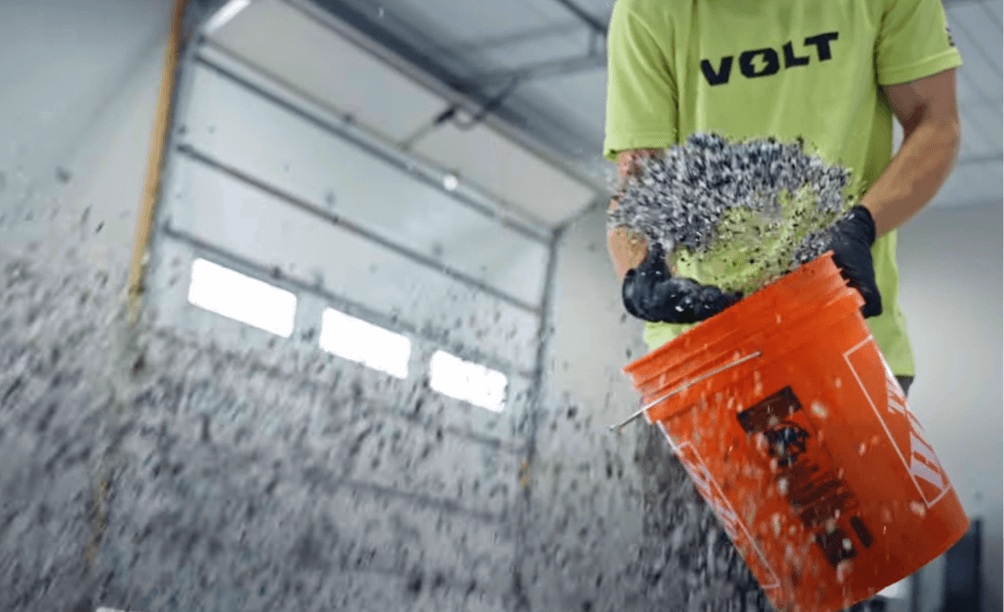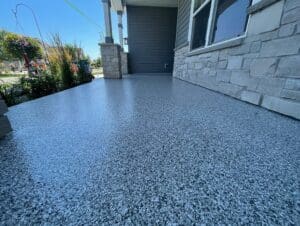Minnesota Flooring Solutions: Why Polyurea is the Best Choice for Your Garage
When it comes to protecting and enhancing your garage floor in Minneapolis, Eden Prairie, Chanhassen, or Plymouth, the options can be overwhelming. With Minnesota’s extreme weather—from frigid winters with snow and salt to wet springs and scorching summers—it’s essential to choose a flooring system that can withstand these challenges. Among the various coatings available, polyurea garage floor coatings have gained significant attention for their durability, versatility, and aesthetic appeal. If you’re considering upgrading your garage floor, you likely have several questions about polyurea coatings, such as how they compare to other popular options like epoxy and polyaspartic, what benefits they offer, and what the installation and maintenance processes entail. Investing in the right garage floor coating is important for both the functionality and appearance of your garage. A well-coated garage floor can withstand daily wear and tear from vehicles, heavy machinery, and various household activities while adding a touch of elegance to your space. In this article, we will address the top questions homeowners in Minneapolis, Eden Prairie, Chanhassen, and Plymouth ask about polyurea garage floors, providing you with the insights needed to make an informed decision.
What is Polyurea and How Does It Compare to Other Coatings?
Definition and Composition of Polyurea
Polyurea is a synthetic polymer formed through a chemical reaction between isocyanates and amines, such as polyetheramines. This reaction, known as step-growth polymerization, results in a strong and flexible material that is highly durable and resistant to various environmental factors. The core components of polyurea include isocyanates, which are highly reactive chemicals characterized by the isocyanate group (-N=C=O), and amines, particularly polyetheramines, which contain multiple amine groups (-NH2). These components react to form strong urethane or urea linkages, resulting in a robust polymer with excellent mechanical properties.
Comparison with Epoxy and Other Floor Coatings
When considering garage floor coatings in Minnesota, polyurea is often compared to other popular options like epoxy and polyaspartic. Here’s how polyurea stands out:
Polyurea vs. Epoxy
Polyurea coatings are generally tougher and more flexible than epoxy coatings. They offer superior resistance to chemicals, impacts, and temperature changes, making them ideal for busy garages in Minneapolis and beyond. Unlike epoxy, which can be brittle and prone to cracking, polyurea maintains its integrity under stress and can adapt to substrate movements without cracking or peeling. Additionally, polyurea cures much faster than epoxy, often within minutes, allowing for quicker application and minimal downtime. This rapid curing time is a significant advantage in construction and renovation projects.
Polyurea vs. Polyaspartic
Polyaspartic coatings, while also durable and fast-curing, differ from polyurea in their composition and properties. Polyaspartic coatings are typically less flexible and may not offer the same level of chemical resistance. However, they are known for their clear, high-gloss finish and are often used as a top coat to enhance the appearance of the floor. In contrast, polyurea provides a more comprehensive protective layer due to its superior flexibility and elongation properties. This makes polyurea particularly suitable for surfaces that experience frequent movement or temperature fluctuations, common in Minnesota’s dynamic climate.
Other Key Differences
Polyurea coatings also outperform other floor coatings in terms of their waterproofing capabilities, impact resistance, and adhesion to various substrates. Unlike some coatings that require primers or sealers, polyurea can be applied directly to the surface, ensuring strong adhesion and minimizing the need for additional preparation steps. In summary, polyurea stands out from other floor coatings due to its exceptional durability, flexibility, and rapid curing time, making it an ideal choice for garage floors that need to withstand heavy use and harsh conditions in Minnesota.
What Are the Benefits of Installing a Polyurea Garage Floor?
Durability and Lifespan
One of the most significant benefits of installing a polyurea garage floor in Minnesota is its exceptional durability and long lifespan. Polyurea coatings are renowned for their ability to withstand heavy use and harsh conditions, making them an ideal choice for garages that experience frequent traffic and exposure to various substances. Polyurea is significantly more durable than other coatings, such as epoxy. It is approximately 20 times more durable and can last for over 25 years without the need for major repairs or replacements. This durability is attributed to its flexibility, which allows it to expand and contract with the concrete substrate, preventing cracks and damage from temperature changes and substrate movements. Additionally, polyurea coatings are highly resistant to chemicals, oils, and other substances that can damage garage floors. They provide an impenetrable barrier against moisture and unwanted pests, ensuring that the concrete beneath remains protected and intact.
Visual Appeal and Customization Options
Beyond its functional benefits, a polyurea garage floor also offers a high level of visual appeal and customization options. Unlike plain concrete, polyurea coatings can be tailored to match your desired style and decor. Polyurea coatings can be applied in multiple layers with various textures and colors, offering a wide range of aesthetic options. This includes the use of vinyl chips and other aggregates to create textured, slip-resistant surfaces, as well as clear top coats to enhance the gloss and appearance of the floor. The customization possibilities with polyurea are extensive, allowing homeowners in Minneapolis, Eden Prairie, Chanhassen, and Plymouth to choose from millions of different colors, designs, and textures. This flexibility ensures that your garage floor not only protects your concrete but also complements the overall aesthetic of your home. Moreover, the incorporation of a polyaspartic top coat in a polyurea application can further enhance the visual appeal by providing excellent abrasion resistance and increased gloss levels, ensuring a long-lasting and visually appealing finish.
Installation and Maintenance of Polyurea Garage Floors
Preparation and Application Process
Installing a polyurea garage floor coating in Minnesota involves several critical steps to ensure a successful and long-lasting application.
Preparation of the Garage Floor
Before applying the polyurea coating, the garage floor must be thoroughly prepared. This begins with a comprehensive cleaning to remove all dust, grease, and debris. This step is essential as any contaminants can affect the adhesion of the coating. Next, the concrete surface needs to be etched or ground to create a textured profile. This can be done through methods such as acid etching or mechanical grinding. Mechanical grinding is often preferred for its consistency and reliability in creating the necessary surface roughness for the coating to bond effectively. Any cracks or imperfections in the floor must be filled with polyurea fillers, which are more durable than traditional fillers. After filling, the surface is smoothed out to create a uniform base for the coating.
Application of the Coating
The application process starts with the polyurea base coat, which is mixed to the ideal consistency for an even application. This base coat is applied using professional-grade tools to ensure complete coverage and a smooth finish. The base coat serves as the foundation for the entire coating system and is essential for forming a durable bond with the concrete. For those who want to add a decorative touch, decorative vinyl flakes can be broadcast onto the wet base coat. These flakes not only enhance the aesthetic appeal but also provide improved slip resistance. After the base coat cures, the flakes are scraped and vacuumed to ensure a smooth surface before applying the topcoat. The final step involves applying the polyurea topcoat, which seals and protects the floor while giving it a polished finish. The topcoat is mixed to the right consistency and applied using squeegees and rollers to guarantee a smooth finish that enhances both the function and appearance of the floor.
Maintenance Requirements
Maintaining a polyurea garage floor in Minnesota is relatively straightforward and involves a few simple steps to ensure the coating remains in excellent condition.
Regular Cleaning
To maintain the shine and integrity of the polyurea coating, regular cleaning is essential. This involves sweeping away dirt and debris and occasionally mopping the floor with a mild detergent. It is important to avoid using abrasive tools or harsh chemicals, as these can damage the coating.
Avoiding Abrasive Materials
Using soft cleaning materials is important to prevent unnecessary wear on the polyurea coating. Avoiding abrasive tools, such as scrub brushes or high-pressure washes, helps maintain the coating’s durability and appearance.
Inspecting for Damage
Periodically inspecting the floor for any signs of damage, such as cracks or peeling, is important. Addressing these issues promptly can prevent them from becoming more serious problems that could compromise the integrity of the coating. By following these maintenance steps, you can ensure your polyurea garage floor remains resilient, visually appealing, and functional for many years.
Conclusion
In conclusion, polyurea garage floor coatings offer a robust, durable, and visually appealing solution for homeowners and businesses in Minneapolis, Eden Prairie, Chanhassen, and Plymouth. With their exceptional durability, rapid curing time, and high resistance to chemicals and impacts, polyurea coatings are an excellent choice for protecting and enhancing your garage floor. To ensure a professional and long-lasting installation, it is essential to choose a reputable and experienced provider. Our team specializes in high-performance concrete coatings, including polyurea, epoxy, and polyaspartic systems. Our certified installers and commitment to superior craftsmanship guarantee a beautiful and durable finish that meets your specific needs. Whether you are transforming your garage into a workshop, home gym, or simply revitalizing it, we can help you achieve the perfect balance of function and aesthetics. Contact us today to get started on your garage floor coating project and experience the difference that our next-gen high-performance coatings can make.
FAQ
How often should I clean my polyurea garage floor to maintain its condition?
To maintain the condition of your polyurea garage floor, clean it regularly. Sweep or vacuum the floor at least once a week to remove debris. A thorough cleaning with a mild detergent and a hose or pressure washer is recommended on a monthly basis, especially during winter months when more dirt and grime are tracked in.
What are the best cleaning solutions and methods to use on a polyurea garage floor?
For cleaning a polyurea garage floor, use mild detergents and gentle cleaning solutions. Here are the key steps:
- Sweep or vacuum the floor to remove loose debris.
- Use a pH-neutral cleaner or a cleaner specifically designed for polyurea surfaces. Crystal Simple Green is highly recommended for its effectiveness and safety.
- Avoid harsh chemicals, abrasive cleaners, and high-pressure nozzles.
- Mop the floor with the chosen cleaner, then rinse thoroughly with clean water to remove any residue.
- Dry the surface completely to prevent water spots and damage.
How do I handle and repair minor scratches and scuffs on my polyurea garage floor?
To repair minor scratches and scuffs on a polyurea garage floor, start by cleaning the area thoroughly with a mild soap and water solution to remove dirt and dust. Use fine-grit sandpaper, wetted with a soapy water solution, to gently rub the scratched areas, maintaining consistent pressure. After sanding, apply a polish corresponding to the polyurea coating and rub it in circular motions until the scratches are minimized. For deeper scratches, you may need to apply a urethane coating or a repair material like a polyaspartic or epoxy-based product, following the manufacturer’s mixing and application instructions.
What is the typical lifespan of a polyurea garage floor coating, and what factors affect its durability?
The typical lifespan of a polyurea garage floor coating is between 10 to 40 years or more, depending on several factors. Key factors include:
- Quality of Installation: Proper installation is essential for longevity.
- Surface Preparation: The surface must be thoroughly cleaned and prepped to prevent future issues.
- Traffic Levels: High-traffic areas may reduce the lifespan, but the coating still lasts long.
- Usage and Maintenance: Regular cleaning and avoiding harsh chemicals help preserve the coating.
- System Used: The type of coating system (e.g., two-coat, three-coat, full broadcast) affects durability.



